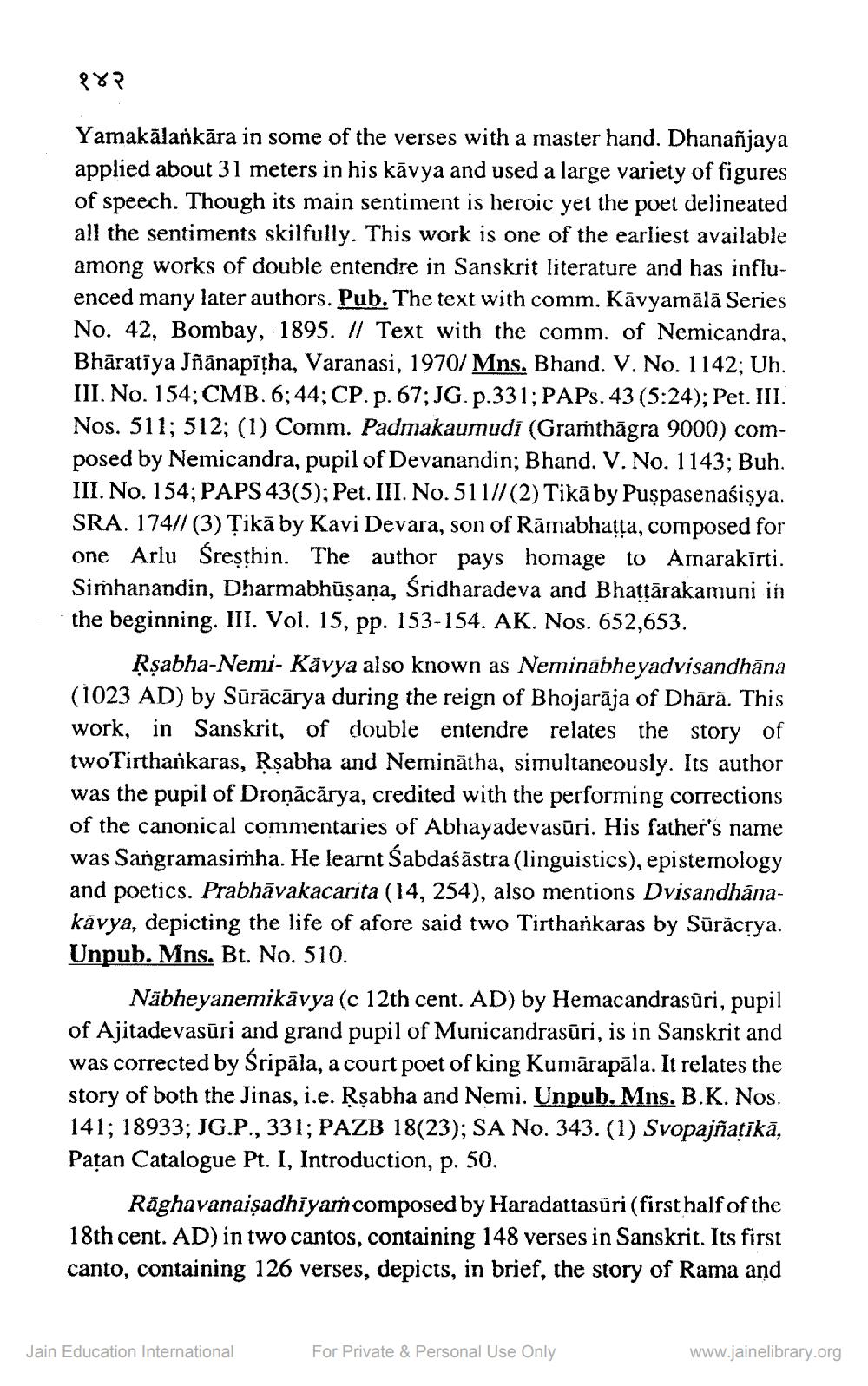________________
982
Yamakālankāra in some of the verses with a master hand. Dhanañjaya applied about 31 meters in his kāvya and used a large variety of figures of speech. Though its main sentiment is heroic yet the poet delineated all the sentiments skilfully. This work is one of the earliest available among works of double entendre in Sanskrit literature and has influenced many later authors. Pub. The text with comm. Kāvyamālā Series No. 42, Bombay, 1895. // Text with the comm. of Nemicandra, Bhāratiya Jñānapīķha, Varanasi, 1970/Mns. Bhand. V. No. 1142; Uh. III. No. 154; CMB. 6; 44; CP. p. 67; JG.p.331; PAPs.43 (5:24); Pet. III. Nos. 511; 512; (1) Comm. Padmakaumudi (Graṁthāgra 9000) composed by Nemicandra, pupil of Devanandin; Bhand. V. No. 1143; Buh. III. No. 154;PAPS 43(5); Pet. III. No.511// (2) Tikā by Puspasenaśisya. SRA. 1747/ (3) Ţikā by Kavi Devara, son of Rāmabhatta, composed for one Arlu Śreșthin. The author pays homage to Amarakirti. Simhanandin, Dharmabhūṣaṇa, Śridharadeva and Bhattārakamuni in the beginning. III. Vol. 15, pp. 153-154. AK. Nos. 652,653.
Rşabha-Nemi- Kävya also known as Neminābheyadvisandhāna (1023 AD) by Sūrācārya during the reign of Bhojarāja of Dhārā. This work, in Sanskrit, of double entendre relates the story of twoTirthankaras, Rşabha and Neminātha, simultaneously. Its author was the pupil of Droņācārya, credited with the performing corrections of the canonical commentaries of Abhayadevasūri. His father's name was Sangramasimha. He learnt Sabdaśāstra (linguistics), epistemology and poetics. Prabhāvakacarita (14, 254), also mentions Dvisandhánakavya, depicting the life of afore said two Tirthankaras by Sūrācrya. Unpub. Mns. Bt. No. 510.
Näbheyanemikāvya (c 12th cent. AD) by Hemacandrasūri, pupil of Ajitadevasūri and grand pupil of Municandrasūri, is in Sanskrit and was corrected by Sripāla, a court poet of king Kumārapāla. It relates the story of both the Jinas, i.e. Rşabha and Nemi. Unpub. Mns. B.K. Nos, 141; 18933; JG.P., 331; PAZB 18(23); SA No. 343. (1) Svopajñatikā, Patan Catalogue Pt. I, Introduction, p. 50.
Rāghavanaişadhiyar composed by Haradattasűri (first half of the 18th cent. AD) in two cantos, containing 148 verses in Sanskrit. Its first canto, containing 126 verses, depicts, in brief, the story of Rama and
Jain Education International
For Private & Personal Use Only
www.jainelibrary.org




